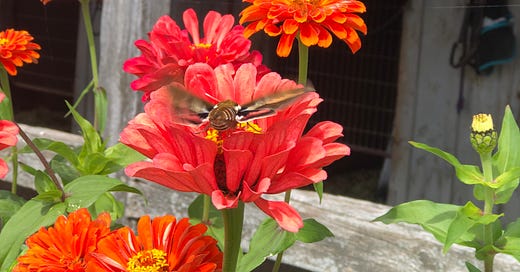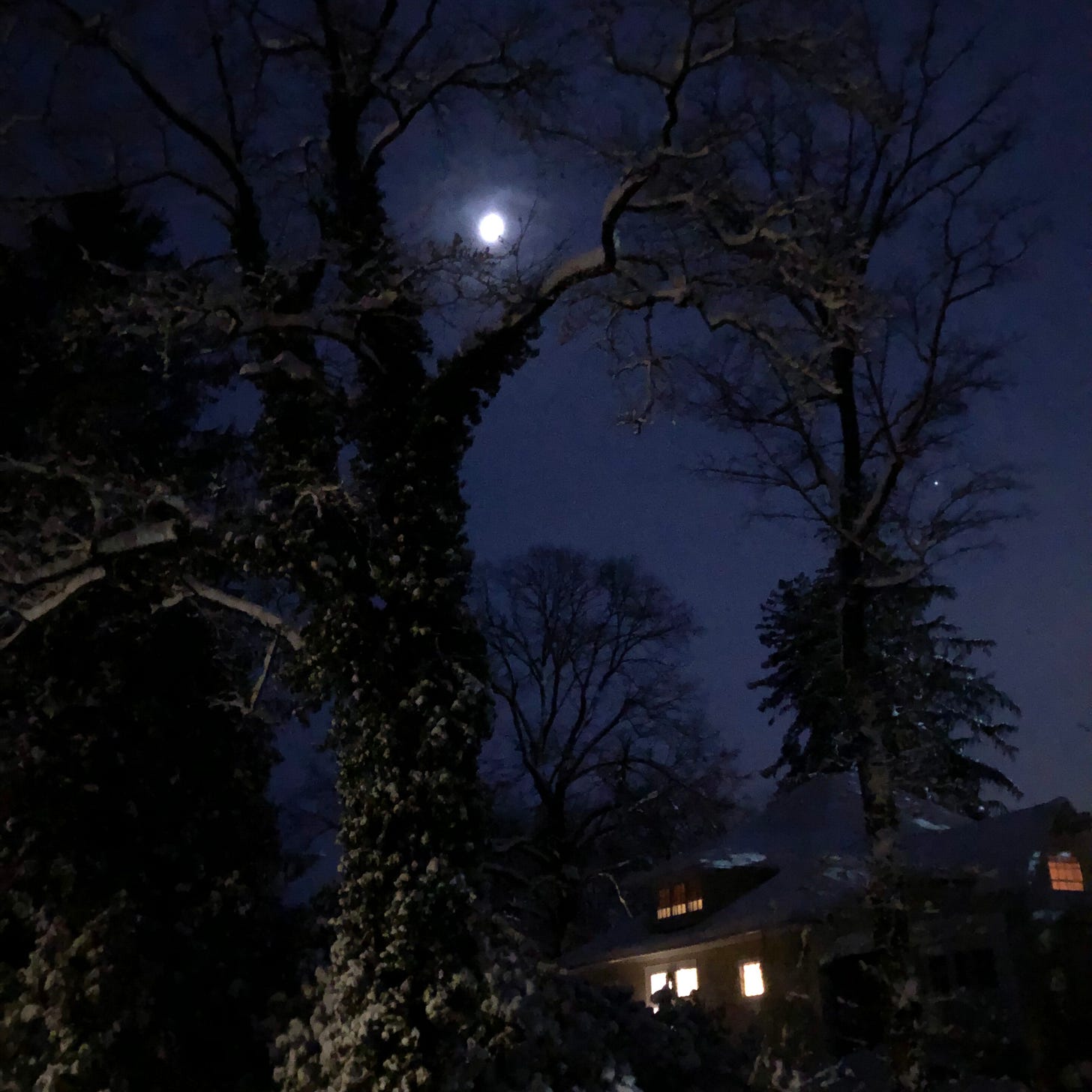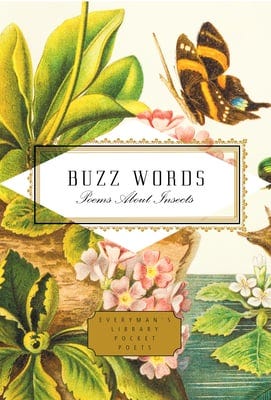Dear Reader,
We’ve got piles of SNOW! At twilight today, I took a break from writing and hiked down to the Bookshop to pick up some cool books. The moonrise on the way back reminded me of one my favorite childhood poems, “The Crescent Moon” by Amy Lowell, from one of my favorite childhood books, The Tall Book of Make Believe. This moon is blurred in my cell phone photo, but I promise you that it is a crescent moon. The poem begins this way:
Slipping softly through the sky Little horned, happy moon, Can you hear me up so high? Will you come down soon?
As we begin the New Year, I want to tell you about a book that I think is genuinely important. I do hope that scientists will write more books for general audiences, and this one is a perfect example of what they can offer the public. With decades of experience in studying insects, Dave Goulson has the deep expertise, careful temperament, and moral authority to issue an urgent alarm.
Review
Silent Earth: Averting the Insect Apocalypse
Dave Goulson
Harper, 2021
328 pages
$28.99
In memoriam E. O. Wilson
A surprise hit during the pandemic has been Clarkson’s Farm, the reality series hosted by British TV personality Jeremy Clarkson (of Top Gear fame). Clarkson is the quintessential grumpy old white guy, a bit overfed and more than a bit overfull of himself. After his tenant farmer retires, he and his girlfriend Lisa decide to take over the farming of his 1,000-acre estate in the Cotswolds (which he calls Diddly Squat Farm). By way of assistance, Clarkson hires a grim-faced agricultural manager named Charlie and an exuberant young farmer named Kaleb. These two blokes spend the ensuing year trying to help Clarkson fix his many mistakes without yelling too much or laughing too hard in his face, as he attempts to maneuver his oversized Lamborghini tractor and master his oversized ego.
While the show is very entertaining, it is also, in its way, quite informative about farming today. During the course of the first season, the UK experiences extreme weather, including both historic drought and flood making the harvest a total roller-coaster. Because he hasn’t used neonicotinoid-coated seeds, Clarkson loses his rapeseed crop to the flea beetle. And he ends up fencing off a pond he has built as part of a “re-wilding” project, because local wildlife begin poaching the trout he plans to sell to a local restaurant. Season 2 is in the works.
About those sprays. We see Clarkson and Kaleb spraying crops extensively with various poisons, though we aren’t told which ones. In an interview last summer, Clarkson suggested that if he and other UK and European farmers can’t grow rapeseed with the help of poison sprays that would push consumers toward Asian palm oil. “So then people say you must not hurt the orangutans, so then you can’t have any form of oil . . . So it’s always a balance, it’s always a struggle, everything you ever do. There is nothing organic on my farm. Nothing.”
I was watching Clarkson’s Farm around the same time that I was reading Silent Earth by Dave Goulson, the noted UK entomolgist and professor at the University of Sussex in the UK. Actually, I first listened to the audio version as read by Goulson himself, before reading my print copy. There is no better way to experience the tone of this important book than to hear it in Goulson’s own gentle voice. In an earlier time, this thoughtful scientist might have been able to spend his whole career considering the questions of bumblebee behavior that had fascinated him at the start of his research.
There is so much to learn about bugs! And so much we have yet to understand. Insects are by far the most successful creatures on earth, thanks to their adaptability and ingenious designs. With superpowers like flight, metamorphosis, and complex organization, insects are all over the earth—and are rarely more than a meter away from any of us. Just the other night, and seemingly out of nowhere, a ladybug appeared at the edge of my dinner plate. Insects are also woefully understudied. We have identified and named about one million insect species, but an estimated four million more remain unidentified and unstudied. In a books-collide moment, Goulson describes a kind of insect from Ecuador that may have evolved to scare off predators by mimicking the invasive fungal infection described in gory detail by Merlin Sheldrake in Entangled Life (see Frugal Chariot Issue 25). Behold the globe-bearing tree hopper!
In the early part of his book, Goulson reviews the history, importance, and sheer magnificent wonder of insects. He also explains the work that insects do to make all our terrestrial food webs function. You may think midges are awful, but did you know they are sole pollinators of the cacao tree? Insects are pollen logisticians, carrion processors, dung handlers, soil engineers—and yes, they are important controllers of pests, including other insects. They are also critical food sources for legions of species. These are essential workers, and they need and deserve protection.
Starting about twenty years ago, Goulson began to ponder a disturbing question: why did so many insect populations appear to be declining in so many areas? With a wide range of collaborators, he started writing papers like “Causes of Rarity in Bumblebees” (2003). Then in 2016, he received a bombshell dataset from a group of entomologists in Germany, taken from a nature reserve called Krefeld. Goulson sets the stage for the Krefeld data by first providing broader context for the overall global collapse in biodiversity. From 1970 to 2014, the total population of wild vertebrates has declined about 60%. Wild mammals now account for only about 4% of total mammalian biomass. 70% of global bird biomass consists of domesticated poultry grown for eggs and slaughter.
Still, when Goulson plotted the Krefeld data he had been sent, “I thought initially there must have been some sort of mistake.” But indeed, the numbers showed a 76% decline in insect biomass from 1989 to 2016. The Krefeld results, which provoked skepticism from leading journals because the numbers were so drastic, have now been confirmed by multiple studies from around the world (though trends in the Global South are not nearly as well studied). Certain bird species that depend on insects, including the cuckoo and the spotted flycatcher, are also in precipitous decline.
The heart of Silent Earth is Goulson’s exploration of the causes for the decline of insects. Unsurprisingly, these causes are numerous, complex, and often mutually reinforcing. They include habitat loss, poison sprays and poison-coated seeds, fertilizers, climate change, light pollution, invasive species, and possibly even electro-magnetic radiation from cell phone towers. Though Goulson walks through all of these carefully and without histrionics, he goes on to offer a devastating argument that the chemical industry has steamrollered piles of evidence that the sprays and seeds they market as safe are building up in insects’ habitats, and killing them.
How neonicotinoids can still be legal in the United States beggars the imagination. They are banned in the EU. But at least the Biden administration has taken initial steps and put these chemicals under expedited review. If it weren’t for the research of groups like the Natural Resources Defense Council, as well as their advocacy and engagement efforts, we would be in much worse shape. In response to a lawsuit brought by NGOs including EarthJustice against the State of California, a court recently issued a statewide ban on a neonicotinoid called sulfloxaflor. EarthJustice is representing the Pollinator Stewardship Council in a separate federal lawsuit against the EPA for its approval of that chemical.
Reports of farmers in China and apple growers in the UK being forced to hand- pollinate their crops do not bode well for the rainbow-colored grocery aisles we have come to expect. As I read Silent Earth, I couldn’t help but think back to an interview that Heather Atwood and I did in 2018 for our podcast The MidPod at the farmer’s market in Fresno, with a Vietnam War veteran and honey producer named Bee Bob. He told us that neonicotinoids were killing hive after hive of his bees. I wonder how Bee Bob’s bees are doing now.
Silent Earth concludes with an optimistic message: that insect declines can be reversed if we humans engage in concerted action. Goulson points out that unlike other environmental crises, this one is highly amenable to mitigation at the community and individual levels. Indeed, my neighbor Gina has recently led a Lawn to Habitat initiative to make our town of Manchester, Massachusetts more pollinator-friendly, by reducing the mowing of certain town properties and encouraging the planting of species that pollinators favor. Citizen science is another powerful tool in the fight to preserve insects. Nora Caplan-Bricker’s essay “Long May They Reign” is a beautiful and profound account of efforts to monitor and conserve Monarch butterfly populations in North America. We can also stop using flea collars on our pets and Roundup in our gardens. We should cultivate vegetable patches of any size and compost our food waste.
I have to confess that I approached Silent Earth with one eyebrow raised just a tiny bit. Dave Goulson has squarely positioned his book as a successor to Silent Spring, the landmark 1962 work of ecological alarm by Rachel Carson. Carson’s is quite a mantle to take on in this way. But I came to feel that Goulson and his publishers were right to do so. The tragic fact of the matter is that while Carson initiated the ultimately successful battle against DDT, we’ve since lost the war against the purveyors of the poisonous chemicals that are sprayed on our food and on our habitats, with reckless abandon and consistent assurances of safety. If we want to reverse insect declines, agriculture is the activity most in need of urgent reform, and Dave Goulson and his colleagues in the scientific community are full of constructive ideas about what might work.
In my ideal 2022, Jeremy Clarkson will invite Dave Goulson to his farm in Chipping Norton. Maybe over tea and scones—with local honey of course—they could hatch a plan for Diddly Squat Farm to become a model for insect-friendly agriculture. Farming is a struggle, and it’s only going to get harder with climate change. But it shouldn’t be a fight to the death against the creatures that make it possible.
As Goulson writes,
None of this is impossible or even difficult. We have to change. We have to learn to live in harmony with nature, seeing ourselves as part of it, not trying to rule and control it with an iron fist. Our survival depends upon it, as does that of the glorious pageant of life with which we share our planet.
Other Voices, Other Forms
There is a wonderful recent trend of nature photographers making their own highly personal documentaries. My Octopus Teacher, for example, was a fantastic film. During lockdown, veteran wildlife photographer Martin Dorhn trained his specialty lenses and gizmos on his own urban backyard garden, and produced the gorgeous film My Garden of a Thousand Bees. It’s currently available for streaming via PBS.
Poems of the Week
The Twitterati were full of splendid suggestions yet again as I searched for the perfect poem this week, and please check this thread for some beauties. Thanks also to Alicia Stallings for alerting me to the newish anthology of insect poems entitled Buzzwords, from Everyman’s Library. This is a great selection, and it has an introduction by Kimiko Hahn.
In the end, I couldn’t choose just one.
First is a treasure from Thomas Hardy that speaks directly to this question of human dominion (oppression?) over our fellow creatures.
An August Midnight
I
A shaded lamp and a waving blind,
And the beat of a clock from a distant floor:
On this scene enter--winged, horned, and spined -
A longlegs, a moth, and a dumbledore;
While 'mid my page there idly stands
A sleepy fly, that rubs its hands . . .
II
Thus meet we five, in this still place,
At this point of time, at this point in space.
- My guests parade my new-penned ink,
Or bang at the lamp-glass, whirl, and sink.
"God's humblest, they!" I muse. Yet why?
They know Earth-secrets that know not I.
~Thomas Hardy
And, I must share this favorite. R.I.P. Robert Bly.
Last Night As I Was Sleeping
Last night as I was sleeping,
I dreamt—marvelous error!—
that a spring was breaking
out in my heart.
I said: Along which secret aqueduct,
Oh water, are you coming to me,
water of a new life
that I have never drunk?
Last night as I was sleeping,
I dreamt—marvelous error!—
that I had a beehive
here inside my heart.
And the golden bees
were making white combs
and sweet honey
from my old failures.
Last night as I was sleeping,
I dreamt—marvelous error!—
that a fiery sun was giving
light inside my heart.
It was fiery because I felt
warmth as from a hearth,
and sun because it gave light
and brought tears to my eyes.
Last night as I slept,
I dreamt—marvelous error!—
that it was God I had
here inside my heart.
~ Antonio Machado (translated by Robert Bly)
For Your Reading Radar
The Electricity of Every Living Thing by Katherine May comes highly recommended by the crew of the Backlisted podcast, which is my mainstay literary listen. May walks along the 630-mile South West Coast Path of England as she reflects on the challenges of motherhood and the realization that she may be autistic.
Bookshop of the Week
Here’s Jeremy Clarkson hawking his book in front of Jaffé & Neal, a spiffy bookshop in Chipping Norton.
That’s it for this week. If you’ve got snow, go play in it! If you don’t, go play anyway!
xo Nicie








